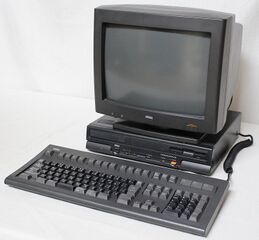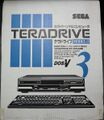Difference between revisions of "Teradrive"
From Sega Retro
| Line 3: | Line 3: | ||
| consoleimage=Teradrive.jpg | | consoleimage=Teradrive.jpg | ||
| imgwidth=320 | | imgwidth=320 | ||
| − | | maker=IBM, [[Sega]] | + | | maker=[[IBM]], [[Sega]] |
| variants= | | variants= | ||
| add-ons= | | add-ons= | ||
| − | |||
| releases={{releasesMD | | releases={{releasesMD | ||
| md_date_jp=1991-05-31 | | md_date_jp=1991-05-31 | ||
| Line 19: | Line 18: | ||
}} | }} | ||
}} | }} | ||
| − | The ''' | + | The '''{{PAGENAME}}''' (テラドライブ) is a hybrid computer system developed by [[Sega]] and [[IBM]] containing both an [[IBM PC]] and [[Sega Mega Drive]]. It was released exclusively in Japan in May 1991. |
==Hardware== | ==Hardware== | ||
| − | + | The Teradrive was designed to fullfil two roles, being a fully fledged IBM PC AT-class PC system also capable of running Mega Drive games through standard cartridges. Three models were made available with different RAM, floppy disk and hard drive configurations (for the PC side), alongside a full keyboard, two-button mouse, full colour monitor (all in black plastic) and range of specialised software. Like other IBM compatibles, the system can be modified and expanded by users if necessary. | |
| − | + | The Teradrive was always envisioned as a low cost machine for the home, which is reflected in its choice to use IBM's PS/2 Model 30 286 as a base for the PC side (itself one of the lower cost variants of the PS/2 family). By 1991, more advanced 386 and 486 computers (including those sold by IBM) were becoming more common, and in some cases were actually cheaper than any of the three Teradrive configurations. Sega instead emphasised the fact the machine had two processors (though technically it has three), with the Mega Drive's [[68000]] playing a role in advertising. | |
| − | + | As a Mega Drive, it is identical to a standard NTSC-J console, but lacks any support for the [[Sega Mega-CD]] or [[Sega 32X]]. While the Mega-CD was not announced until after the Teradrive's launch, support for it was planned, with Sega creating at least two prototype Mega-CD units around the Teradrive's (otherwise unused) expansion port. Poor sales of the Teradrive meant development of this add-on was cancelled before designs left the prototype stage. | |
| − | + | The Teradrive also allows some degree of interaction between the PC and Mega Drive hardware. The only known software to make use of this is ''[[Puzzle Construction]]'', which was included with the Teradrive. Exactly how the x86 code communicates with the Mega Drive hardware, and the limits of what is possible through this interface, are currently unknown. | |
| + | |||
| + | Teradrives have a unique BIOS and menu system, however all shipped with IBM DOS J4.0/V and is expected to run all compatible software. Windows 3.0 was also advertised as being compatible. | ||
| + | |||
| + | ===Technical specifications=== | ||
| + | {{otherPage|desc=Mega Drive specifications|page=Sega Mega Drive/Technical specifications}} | ||
| + | The Teradrive came in three different models with the main differences being RAM, storage, and price, aptly named Models 1-through-3. | ||
| + | |||
| + | ====All models (PC side)==== | ||
| + | *Processor: 10MHz Intel 80286 | ||
| + | *Maximum supported RAM: 2.5MB | ||
| + | *Graphics: VGA | ||
| + | ** 640x480 (262144 colors/16 on-screen) | ||
| + | ** 320x200 (262144 colors/256 on-screen) | ||
| + | *Sound: PC speaker | ||
| + | *I/O ports: VGA, parallel, 1x RS232 serial, 2x PS/2, 2x Mega Drive controller ports, unused Mega-CD expansion, 15-pin RGB connector | ||
| − | |||
| − | |||
====Model 1==== | ====Model 1==== | ||
| − | + | *RAM: 640KB | |
| − | + | *Floppy disk drive: 1x 3½-inch 2HD | |
| − | * RAM | + | *Price: ¥148,000 |
| − | * | + | |
| − | |||
| − | |||
| − | |||
| − | |||
| − | |||
| − | |||
| − | |||
| − | |||
| − | |||
| − | |||
| − | * | ||
| − | |||
| − | |||
| − | |||
| − | |||
| − | |||
| − | |||
| − | |||
| − | |||
====Model 2==== | ====Model 2==== | ||
| − | + | *RAM: 1MB | |
| − | + | *Floppy disk drive: 2x 3½-inch 2HD | |
| − | * RAM | + | *Price: ¥188,000 |
| − | * | + | |
| − | |||
| − | |||
| − | |||
| − | |||
| − | |||
| − | |||
| − | |||
| − | |||
| − | |||
| − | |||
| − | * | ||
| − | |||
| − | |||
| − | |||
| − | |||
| − | |||
| − | |||
| − | |||
| − | |||
====Model 3==== | ====Model 3==== | ||
| − | + | *RAM: 2.5MB | |
| − | + | *Floppy disk drive: 1x 3½-inch 2HD | |
| − | * RAM | + | *Storage: 30MB HDD (with DOS/V already installed) |
| − | * | + | *Price: ¥248,000 |
| − | * Storage: | ||
| − | |||
| − | |||
| − | |||
| − | |||
| − | |||
| − | |||
| − | |||
| − | |||
| − | |||
| − | |||
| − | |||
| − | |||
| − | |||
| − | |||
| − | |||
| − | |||
| − | * Price ¥248,000 | ||
| − | |||
==Magazine articles== | ==Magazine articles== | ||
| Line 160: | Line 115: | ||
==References== | ==References== | ||
| − | <references/> | + | <references /> |
{{MegaDrive}} | {{MegaDrive}} | ||
Revision as of 16:37, 15 July 2020

| ||||||||||||||||||||
| Teradrive | ||||||||||||||||||||
|---|---|---|---|---|---|---|---|---|---|---|---|---|---|---|---|---|---|---|---|---|
| Manufacturer: IBM, Sega | ||||||||||||||||||||
|
The Teradrive (テラドライブ) is a hybrid computer system developed by Sega and IBM containing both an IBM PC and Sega Mega Drive. It was released exclusively in Japan in May 1991.
Contents
Hardware
The Teradrive was designed to fullfil two roles, being a fully fledged IBM PC AT-class PC system also capable of running Mega Drive games through standard cartridges. Three models were made available with different RAM, floppy disk and hard drive configurations (for the PC side), alongside a full keyboard, two-button mouse, full colour monitor (all in black plastic) and range of specialised software. Like other IBM compatibles, the system can be modified and expanded by users if necessary.
The Teradrive was always envisioned as a low cost machine for the home, which is reflected in its choice to use IBM's PS/2 Model 30 286 as a base for the PC side (itself one of the lower cost variants of the PS/2 family). By 1991, more advanced 386 and 486 computers (including those sold by IBM) were becoming more common, and in some cases were actually cheaper than any of the three Teradrive configurations. Sega instead emphasised the fact the machine had two processors (though technically it has three), with the Mega Drive's 68000 playing a role in advertising.
As a Mega Drive, it is identical to a standard NTSC-J console, but lacks any support for the Sega Mega-CD or Sega 32X. While the Mega-CD was not announced until after the Teradrive's launch, support for it was planned, with Sega creating at least two prototype Mega-CD units around the Teradrive's (otherwise unused) expansion port. Poor sales of the Teradrive meant development of this add-on was cancelled before designs left the prototype stage.
The Teradrive also allows some degree of interaction between the PC and Mega Drive hardware. The only known software to make use of this is Puzzle Construction, which was included with the Teradrive. Exactly how the x86 code communicates with the Mega Drive hardware, and the limits of what is possible through this interface, are currently unknown.
Teradrives have a unique BIOS and menu system, however all shipped with IBM DOS J4.0/V and is expected to run all compatible software. Windows 3.0 was also advertised as being compatible.
Technical specifications
- For Mega Drive specifications, see Sega Mega Drive/Technical specifications.
The Teradrive came in three different models with the main differences being RAM, storage, and price, aptly named Models 1-through-3.
All models (PC side)
- Processor: 10MHz Intel 80286
- Maximum supported RAM: 2.5MB
- Graphics: VGA
- 640x480 (262144 colors/16 on-screen)
- 320x200 (262144 colors/256 on-screen)
- Sound: PC speaker
- I/O ports: VGA, parallel, 1x RS232 serial, 2x PS/2, 2x Mega Drive controller ports, unused Mega-CD expansion, 15-pin RGB connector
Model 1
- RAM: 640KB
- Floppy disk drive: 1x 3½-inch 2HD
- Price: ¥148,000
Model 2
- RAM: 1MB
- Floppy disk drive: 2x 3½-inch 2HD
- Price: ¥188,000
Model 3
- RAM: 2.5MB
- Floppy disk drive: 1x 3½-inch 2HD
- Storage: 30MB HDD (with DOS/V already installed)
- Price: ¥248,000
Magazine articles
- Main article: Teradrive/Magazine articles.
Promotional material
- Main article: Teradrive/Promotional material.
Photo gallery
Merchandise
Physical scans
| Teradrive, JP (Model 1) |
|---|
|
| Teradrive, JP (HTR-2200 monitor) |
|---|
|
| Teradrive, JP (HTR-2300A mouse) |
|---|
|
External links
References




